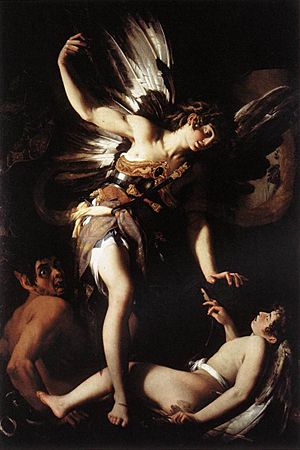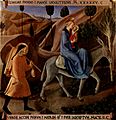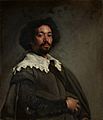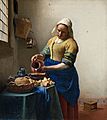Chiaroscuro facts for kids

Chiaroscuro (say "key-ah-roh-SKOOR-oh") is a cool art technique. It means using strong differences between light and dark in a painting or drawing. Artists use it to make their pictures look more dramatic and exciting.
This technique also helps objects in a painting look like they have depth. It makes them seem three-dimensional (3D) instead of flat. You can also see similar light and dark effects in photography and movies.
Contents
What is Chiaroscuro?
Chiaroscuro comes from two Italian words. Chiaro means "light" and scuro means "dark." So, it literally means "light-dark." Artists use this method to create a strong visual impact.
Imagine a spotlight shining on a person in a dark room. The parts of the person hit by the light are bright. The parts in shadow are very dark. This creates a powerful contrast.
How Artists Use Chiaroscuro
Artists use chiaroscuro for several reasons. It helps them control where your eye looks in a picture. It also adds emotion and realism.
Making Things Look 3D
One main goal of chiaroscuro is to show volume. It makes figures and objects look solid and round. By carefully placing highlights and shadows, artists can create the illusion of depth. This makes a flat canvas seem to have real shapes.
For example, a painter might make one side of a face very bright. The other side would be in deep shadow. This makes the face look like it's sticking out from the canvas. It gives it a lifelike, sculpted feel.
Creating Drama and Mood
Chiaroscuro is also great for making a scene feel dramatic. The sharp contrast between light and dark can create tension. It can also make a moment feel very important.
Think about a scary movie scene. Often, only parts of the characters are lit. The rest of the scene is in deep shadow. This makes you feel suspense and excitement. Artists use chiaroscuro in paintings for the same effect. It can make a quiet scene feel mysterious or a powerful scene feel intense.
Famous Artists Who Used Chiaroscuro
Many famous artists have used chiaroscuro. Some of them became masters of this technique. They used it to define their unique styles.
Caravaggio: The Master of Light
Caravaggio was an Italian painter from the late 1500s. He is one of the most famous users of chiaroscuro. His paintings often feature very bright figures emerging from almost black backgrounds. This extreme contrast is sometimes called "tenebrism."
Caravaggio used light to highlight important parts of his stories. He made his figures look very real and powerful. His style influenced many artists after him.
Rembrandt: Soft Shadows
Rembrandt was a Dutch painter from the 1600s. He also used chiaroscuro, but often in a softer way than Caravaggio. Rembrandt was a master at showing different textures and emotions.
He used subtle shifts from light to dark. This created a warm, glowing effect. His portraits often have a gentle light on the face. The rest of the painting fades into shadow. This makes his subjects feel very human and thoughtful.
Other Artists
Many other artists used chiaroscuro throughout history. Leonardo da Vinci used it to make his figures look soft and lifelike. Fra Angelico and Sandro Botticelli also used it in their early Renaissance works. Later, artists like Joseph Wright of Derby used it to light up scientific experiments. This made the scenes look exciting and new.
Chiaroscuro Beyond Painting
The idea of using light and dark isn't just for paintings. It's a powerful tool in many visual arts.
In Drawings and Prints
Chiaroscuro is also used in drawings and prints. Artists might use dark inks or pencils on light paper. They can also use white chalk or paint on colored paper. This helps them create strong contrasts.
Chiaroscuro woodcuts are a special type of print. They use several blocks of wood. Each block prints a different shade of color. This creates a layered effect of light and dark.
In Photography and Film
In photography and cinematography, lighting is key. Photographers and filmmakers use chiaroscuro to create mood. They can make a scene look dramatic, mysterious, or even scary.
They do this by controlling light sources. They might use a single strong light. Or they might use shadows to hide parts of the scene. This technique helps tell the story and create strong feelings.
Images for kids
-
Christ at Rest, by Hans Holbein the Younger, 1519, a chiaroscuro drawing using pen, ink, and brush, washes, white heightening, on ochre prepared paper
-
Nativity at Night by Geertgen tot Sint Jans, c. 1490, after a composition by Hugo van der Goes of c. 1470; sources of light are the infant Jesus, the shepherds' fire on the hill behind, and the angel who appears to them.
-
Peter Paul Rubens's The Elevation of the Cross (1610–1611) is modelled with dynamic chiaroscuro.
-
Joseph Wright of Derby painted several large groups with strong chiaroscuro, such as A Philosopher Lecturing on the Orrery, 1766
-
Fra Angelico c. 1450 uses chiaroscuro modelling in all elements of the painting
-
Saint Sebastian by Botticelli, 1474
-
Portrait of Juan de Pareja, c. 1650 by Diego Velázquez, uses subtle highlights and shading on the face and clothes
-
The Milkmaid c. 1658, by Johannes Vermeer, whose use of light to model throughout his compositions is exceptionally complex and delicate
-
Delicate engraved lines of hatching and cross-hatching, not all distinguishable in reproduction, are used to model the faces and clothes in this late-fifteenth-century engraving
-
Drawing by Leonardo da Vinci
-
Annunciation by Domenico Beccafumi, 1545–46
-
Allegory, Boy Lighting Candle in Company of Ape and Fool by El Greco, 1589–1592
-
Crucifixion of St. Peter by Caravaggio, 1600
-
The Flight to Egypt by Adam Elsheimer, 1609
-
St. Peter in prison by Rembrandt, 1631
-
The Proposition by Judith Leyster, 1631
-
Magdalene with the Smoking Flame, by Georges de La Tour, c. 1640
-
Adoration of the Shepherds by Matthias Stom, mid-17th century
-
Antoine Watteau – La Partie carrée, c. 1713
-
An Experiment on a Bird in the Air Pump by Joseph Wright of Derby, 1768
-
The Bolt by Jean-Honoré Fragonard, c. 1777
-
Christ on the Mount of Olives by Francisco Goya, 1819
-
Saint Jerome by José de Ribera, 1652
-
An Old Man in Red, by Rembrandt, 1652–1654
-
The Knitting Girl by William-Adolphe Bouguereau, 1869
-
Self-Portrait by John Everett Millais, 1881
-
Saturn, anon. Italian, sixteenth-century?, Italian style chiaroscuro woodcut, with four blocks, but no real line block, and looking rather like a watercolour
See also
 In Spanish: Claroscuro para niños
In Spanish: Claroscuro para niños
































